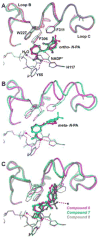AKR1C3 as a target in castrate resistant prostate cancer
- PMID: 23748150
- PMCID: PMC3805777
- DOI: 10.1016/j.jsbmb.2013.05.012
AKR1C3 as a target in castrate resistant prostate cancer
Abstract
Aberrant androgen receptor (AR) activation is the major driver of castrate resistant prostate cancer (CRPC). CRPC is ultimately fatal and more therapeutic agents are needed to treat this disease. Compounds that target the androgen axis by inhibiting androgen biosynthesis and or AR signaling are potential candidates for use in CRPC treatment and are currently being pursued aggressively. Aldo-keto reductase 1C3 (AKR1C3) plays a pivotal role in androgen biosynthesis within the prostate. It catalyzes the 17-ketoreduction of weak androgen precursors to give testosterone and 5α-dihydrotestosterone. AKR1C3 expression and activity has been implicated in the development of CRPC, making it a rational target. Selective inhibition of AKR1C3 will be important, however, due to the presence of closely related isoforms, AKR1C1 and AKR1C2 that are also involved in androgen inactivation. We examine the evidence that supports the vital role of AKR1C3 in CRPC and recent developments in the discovery of potent and selective AKR1C3 inhibitors. This article is part of a Special Issue entitled 'CSR 2013'.
Keywords: Androgens; Nonsteroidal anti-inflammatory drugs; Prostaglandin F synthase; Prostate cancer; Type 5 17β-hydroxysteroid dehydrogenase.
Copyright © 2013 Elsevier Ltd. All rights reserved.
Figures










References
-
- SEER Cancer Statistics Review, 1975–2009. National Cancer Institute; Bethesda, MD: 2010. based on November 2009 SEER data submission, posted to the SEER web site, 2010. http://seer.cancer.gov/statfacts/html/prost.html.
-
- Jemal A, Siegel R, Xu J, Ward E. Cancer statistics, 2010. CA Cancer J Clin. 2010;60(5):277–300. - PubMed
Publication types
MeSH terms
Substances
Grants and funding
LinkOut - more resources
Full Text Sources
Other Literature Sources
Medical
Research Materials

